-

《荷花淀》说课稿 2020-2021学年统编版高中语文选择性必修中册
教师深情旁白,歌手的动情演唱,让学生会沉浸在夫妻之情、家国之爱的深深思索中,此时的课堂气氛应是沉静的。学生在这种情感体验中,一定能写出很精彩的对话]为了将这种课堂的高潮气氛不至于因学习问题的转移而跌落,我又设计了过渡语,在同学们的思绪有点紊乱中(我预想此时同学们的思绪是这样的),教师说:毕竟,藕断丝连的妇女们,对丈夫的不辞而别心存依恋。或许她们还有许多悄悄话还未来得及向自己心爱的丈夫表白;或许她们为丈夫的安全茶饭不思;或许她们有一日不见,如隔三秋的感觉。因此,几个青年妇女就聚在水生家里商量探夫的事。虽然我们未能参与其中,但我们可以听其声,见其人,感其情。不信请……)(这就实现了课堂教学环节的自然巧秒过渡,也同样展示了我的上课风格)

《过秦论》说课稿 2021—2022学年统编版高中语文选择性必修中册
三、教学方法为了突出重点,突破难点,完成教学目标,选择行之有效的教学方法是非常关键的。根据课程标准的要求和本节课的特点,为了关注学生的个体差异和不同的学习需求,充分调动学生学习的积极性,培养学生阅读和分析文章的能力,我主要采用以下的教学方法:1、悬念导入法。用悬念导入能激发起学生对文言文阅读的兴趣,充分调动学生学习的主动性。2、根据教师主导作用与学生主动性相结合的原则,选择了以语言传递信息为主的方法,讲授法。四、学法通过初中的学习,学生对古文知识已经有了一定的掌握,但是对这种古代散文比较少见,特别是叙史和议论结合的写法更是陌生。所以学习这篇课文的时候,通过反复地诵读,分析句型,对比句型的意思,达到疏通文意,这样,学生通过朗读理解法、质疑提问法、自主讨论探究法能复述课文,了解文章层次,理解文章主旨含义。
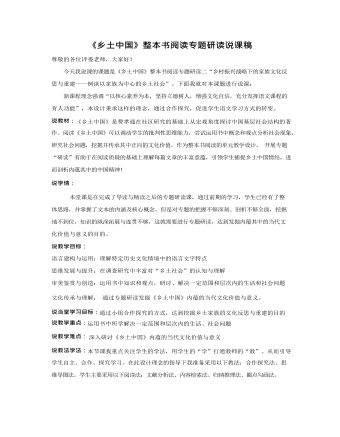
《乡土中国》说课稿 2021-2022学年统编版高中语文必修上册
活动一:整体感知,梳理要点新修订《课程标准》指出:重视学生的思维发展与提升,如直觉思维、形象思维、抽象思维等。为此,我设计了“梳理要点、绘制思维导图”两个部分,引导学生在阅读中整体感知文本。1、梳理章节要点,明确内容要素《家族》:以西洋家庭特点为对照,分析中国乡土社会家庭的特点。《男女有别》:主要讨论乡土社会感情定向的问题,偏向同性交往,遏制男女交往。2、展示思维导图,凸显整体关联引导同学制作多种思维导图:流程图式、树状图式、爪形图式活动二:走进文本,深化认知新修订《课程标准》指出:学会语文运用的方法,有效地提高语文能力,并在学习语言文字运用的过程中促进方法、习惯及情感、态度与价值观的综合发展。所以在教学中我引导学生掌握整本书阅读的基本方法,即以速读、跳读的方式地毯式地搜索书中关于“中西家庭差别”的内容,得出乡土家族的六个方面的特点,学生分别结合生活中的现象阐述了这六个方面的特点在生活中的具体体现。
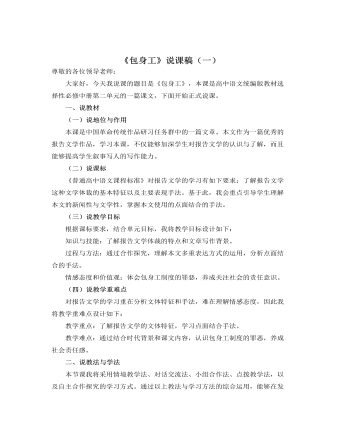
《包身工》说课稿(一) 2021-2022学年统编版高中语文选择性必修中册
首先请同学设想:“如果你是作者,当你准备写一篇以包身工为题材的文章时,会从哪些方面选材?”而“本文又是如何将这些材料组织起来的?”这一环节能够使学生参与到教学过程中来,通过问题能够引导学生关注本文的选材类型和表达方式,区分文中穿插的感性、理性材料,从而理解报告文学兼文学性、议论性于一体的文学特质。然后请同学阅读表现包身工起床情形的场面描写(1-6段),并引导学生分析该段表达效果;再请同学们阅读“芦柴棒”被虐待段(16-20段),并引导同学们比较两个片段在选材上有何区别,进而归纳点面结合的手法的艺术效果。最后请学生找出文中其他运用点面结合手法的段落,并尝试自主分析。这一环节能够引导学生直观地感受本文场面描写的作用,并分析点面结合手法的艺术效果,同时也让学生通过练习探究掌握分析该手法的方法。
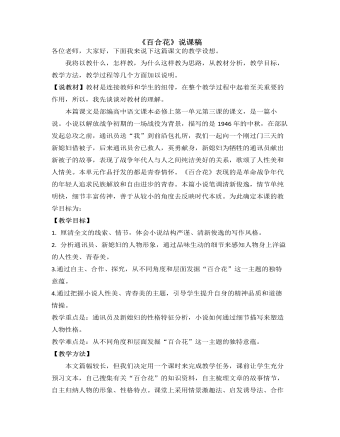
《百合花》说课稿 2021-2022学年统编版高中语文必修上册
1. 厘清全文的线索、情节,体会小说结构严谨、清新俊逸的写作风格。2. 分析通讯员、新媳妇的人物形象,通过品味生动的细节来感知人物身上洋溢的人性美、青春美。3.通过自主、合作、探究,从不同角度和层面发掘“百合花”这一主题的独特意蕴。4.通过把握小说人性美、青春美的主题,引导学生提升自身的精神品质和道德情操。教学重点是:通讯员及新媳妇的性格特征分析,小说如何通过细节描写来塑造人物性格。教学难点是:从不同角度和层面发掘“百合花”这一主题的独特意蕴。【教学方法】本文篇幅较长,但我们决定用一个课时来完成教学任务,课前让学生充分预习文本,自己搜集有关“百合花”的知识资料,自主梳理文章的故事情节,自主归纳人物的形象、性格特点。课堂上采用情景激趣法、启发诱导法、合作探究法等教学方法来引导学生学习探究,培养学生的文学鉴赏能力。

《梦游天姥吟留别》说课稿 2022—2023学年统编版高中语文必修上册
【说教材】《梦游天姥吟留别》是部编版必修上册第三单元的一篇古诗词。这个单元以生命的诗意为主题,汇集了不同时期、不同体式的诗词名作。本诗的作者李白是浪漫主义诗人的代表,他以瑰丽的想象,在这首诗中为我们塑造了一个迷离的梦境。整首诗以七言为主,但不拘格律限制,行笔恣意洒脱,寄寓了自己深沉的身世之感【说学情】初中语文的古诗词教学侧重识记背诵,学生具备了一些文体知识,但还缺乏对古典诗歌进行系统性鉴赏的能力,进入高中阶段,需要指导学生在理解文本表层含义的基础上,深入解读诗歌、表达自己的见解。【说教学目标】根据语文学科素养的要求,我确立了这四个教学目标。语言方面,要能熟读内容,结合注释疏通文意,把握文中的关键字、词、句的含义。思维方面,缘景明情,在诵读过程中分析、感悟诗歌内容。审美鉴赏与创造方面,要能鉴赏梦游的意境,体会李白的浪漫主义诗风,提高鉴赏能力;文化方面,要能够品味诗人情感,感受其追求自由、不慕名利的高尚人格。
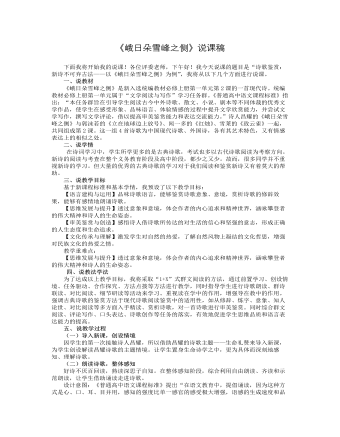
《峨日朵雪峰之侧》说课稿 2021-2022学年统编版高中语文必修上册
(二)朗读诗歌,整体感知好诗不厌百回读,熟读深思子自知。在整体感知阶段,综合利用自由朗读、齐读和示范朗读,让学生借助诵读走进诗歌。 设计意图:《普通高中语文课程标准》提出“在语文教育中,提倡诵读,因为这种方式是心、口、耳、目并用,感知的强度比单一感官的感受极大增强,语感的生成速度和品质都会提高。” 语文学科核心素养之“语言建构与运用”也要求采用语感与语理相互促进的办法来提高语言运用能力,而语感与语理的培养离不开“诵读”这一活动。多读几遍,不仅可使其义自见,也可使其意自明、其理自通、其气自涌。(三)鉴赏诗歌,重点突破在多样的朗读活动之后,我们不难发现,这一首现代诗,它在语意和诗意理解上并不像古典诗歌那样有着语言、历史及手法方面的障碍。但是,这并不代表现代诗就不值得仔细品味、认真咀嚼,经典的现代诗依然有着其浓浓的诗味和诗性。我将借助古典诗歌鉴赏方法来指导学生解读现代诗歌。我们先从学生最熟悉、赏析起来最容易的修辞手法入手,学生呈现了以下自主学习的成果。
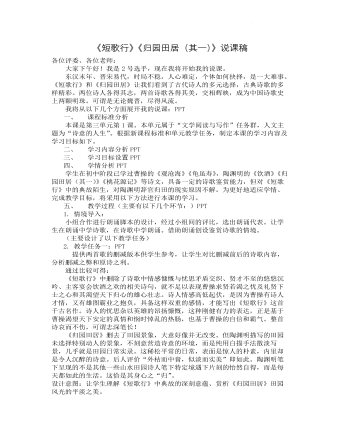
《短歌行》《归园田居》说课稿 2021-2022学年统编版高中语文必修上册
3. 教学任务二:PPT子任务一、二、三感悟诗情:那么为什么不能轻易对诗人诗歌进行删减呢?除了诗歌语言及内容方面的影响外,还有重要的一点就是:感情。情感是诗歌的尺度,而非长短。下面将从知人论世的角度再读诗歌。重点赏析曹操的“忧”与“解”和陶渊明的“误”与“归”。通过编写诗人年谱的方式,呈现诗人的各个人生阶段的经历和当时的时代背景,让诗人回到历史现场,让自己代入诗人境遇,以意逆志。通过查阅资料和编写年谱,可以了解到:曹操既能横槊,又能赋诗,如曹丕在《典论·自叙》中所说:“上(曹操)雅好诗文书籍,虽在军旅,手不释卷。”《短歌行》中多用典故和善用比兴或许就源于此。其次,曹操虽出身仕宦,但门第不算高贵,这样的家庭地位让他有着出人头地、建功立业的迫切愿望,因此,“唯才是举”是曹操出于现实的理性选择。再次,曹操写《短歌行》的确切时间已难考证,如取赤壁大战前的说法,曹操已五十四岁,来日无多的紧迫感、贤才归附的愿望自然尤为强烈。
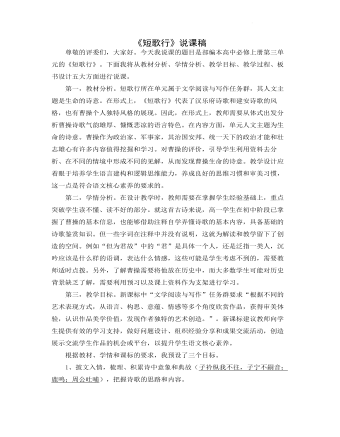
《短歌行》说课稿2022-2023学年统编版高中语文必修上册
第二课时为知人。即利用预习所查到的资料、学生之间的分享以及教师预备的材料,合作探究三个问题:曹操为何如此渴望贤才?天下归心的愿望是否实现?如何评价曹操?本课时采用创设情境的方式,从刘备、曹丕、晚年曹操等多重角度评价曹操,自领角色,利用资料有逻辑地证明自己的观点。教师出示不同学者评价,师生共同研讨评价的技巧和原则,尝试写作短小文学评论。这是解决忧的果。第三课时为回味。创设诵读比赛的情境,在比赛和评价中研讨标点符号的作用,如何读出曹操诗歌独特的特点,以及带着对曹操的认识读出自己的理解。(每组评出最佳朗读者和最佳评论员,上传优秀视频)。这是为了让学生最后读出忧。第五,板书设计。以上是我本节课教学设计的板书,体现了分析本首诗的基本思路和学习方法。
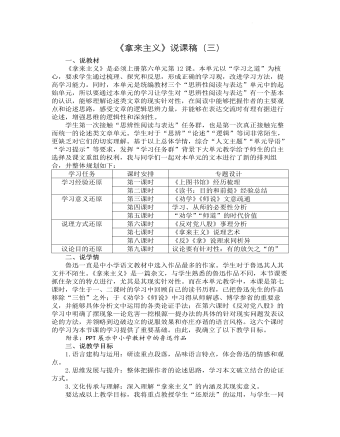
《拿来主义》说课稿(三) 2021-2022学年统编版高中语文必修上册
学生展示:鲁迅在《拿来主义》讨论“送去主义”时使用的不是徐、刘二人欧洲巡展的事实,而是《大晚报》评价二人欧洲巡展为“发扬国光”这一事实,故用了“叫作”,且是加引号的“发扬国光”;用“送”字表明自己针对的对象不是梅兰芳本人及其艺术,而是“送梅兰芳博士到苏联去”的人及其行为,即强行将中国戏剧与象征主义相联系的牵强附会的行径。可见,鲁迅针对的是当时国民政府一味送去的行径和主流媒体宣扬为“发扬国光”的舆论导向。设计意图:有的放矢,针砭时弊是杂文的突出特征。耙子指向哪儿、时弊是什么是必须思考的问题。有学生误以为鲁迅在批判徐悲鸿、刘海粟、梅兰芳等人,甚至调侃说鲁迅“怼人狂魔”“老阴阳师”。通过此活动,细读文本,还原历史,抓住“叫作”与“送”的主体,找准鲁迅批判的对象和针对的现象。同时,引导学生用不可随意使用所谓网络“梗文化”来消解名人、伟人等事迹的严肃性,不可以娱乐心态品读经典作品。
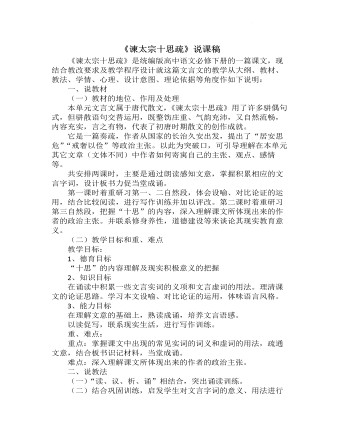
《谏太宗十思疏》说课稿 2021—2022学年统编版高中语文必修下册
三、说学法(一)学情分析经过初中阶段对文言文的学习,学生初步了解一些文言实词的意见、常见虚词的用法以及词性活用、古今异义、通假字等文言现象。但多靠机械记忆,忽略在文章内容及句义章法的理解把握前提下记忆。且较少对点滴的文言知识进行归纳整理。(二)学法指导1、圈点评注法学习课文时用一些简单醒目的符号,在字、词、句、段上勾画,标记疑问,评注阅读时的感受、体会。形成自己的圈点勾画的符号系统,使用符号时不应随意变动,以便重读复习文章。2、通过“粗读”“通读”“品读”“齐读”“个别范读”等多种形式的朗读,指导学生整体把握文章内容及思路。在此前提下,设计迁移阅读,引导学生触类旁通,学以致用,达到以读促说,以读促写。四、说教学程序(第一课时)
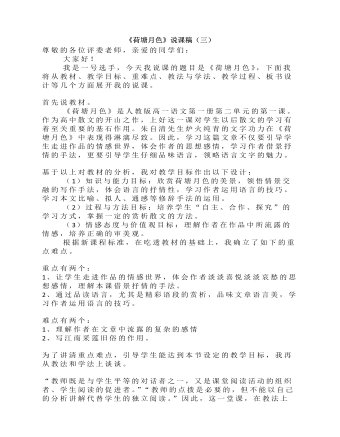
《荷塘月色》说课稿 (三)2022—2023学年统编版高中语文必修上册
环节二,在品读过程中把重点字词的读音和意义融入其中。这是新课程标准的体现环节三,提出问题:作者的思想情感在文中是怎样变化的?让学生带着这个问题再次自读课文。三、仔细品读,把握感情。引导学生去把握全文的感情基调,解决刚才提出的问题。 赏析语段,品味语言,在把握全文感情基调的基础上,启发学生联想,假设眼前有一片荷塘,设问学生会看到什么?很自然会看到:叶,花,闻到花香。在此基础上逐步引导学生赏析课文精彩语段四、五自然段,当然教师要作必要的启发指点,尤其是在那些容易被忽略之处,以下仅举一例: 荷香与歌声有什么可比的共同点?(领会通感手法的运用)在点拨通感这一修辞手法时,我举了诗人艾青描写日本著名指挥家小泽征尔的话:“你的眼睛在,你的耳朵在倾听。”这个例子能诗意的解释通感这一修辞手法。
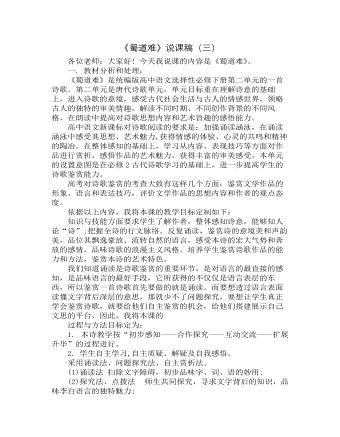
《蜀道难》说课稿(三) 2021-2022学年统编版高中语文选择性必修下册
(3)夸张到极致的技巧: (学生寻找出诗歌中的夸张语句,谈出感受) (4)多样的诗歌意境: 为了表达主观感受与目的的需要,诗歌中构织不同的意境:高峻、宏伟、神奇、凄清、恐怖等各种意境均有描绘,而这些意境又统统表现一个“难”字。 (5)神秘的传说: “五丁开山”“太阳神回车”“子规哀啼”等传说的出现,使全诗笼罩一种神秘气氛,也从另一个角度表现出了一个“难”字。 2、明确诗歌的主旨和情感。 这首诗以咏叹为基调,一叹蜀道之高,二叹蜀道之险,三叹蜀中战祸之烈,而战祸之烈是由于蜀道高险给割据者创造了良好条件的缘故。因此,对军事叛乱的警惕正是诗人的主旨所在。“蜀地不可去,不可居”是其表达的要义。(设计目的在于:1、全面把握诗歌的艺术特色,以便学生写作借鉴,掌握作文的技巧。2、把握诗歌主旨,更深刻理解诗人的情感)
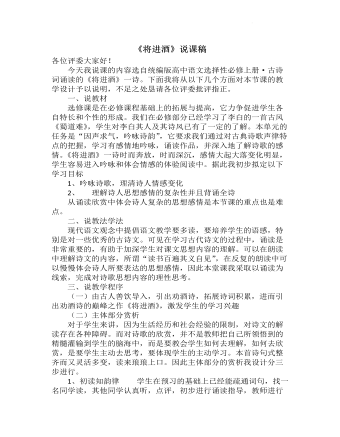
古诗词诵读《将进酒》说课稿2021-2022学年高中语文统编版选择性必修上册
一、说教材选修课是在必修课程基础上的拓展与提高,它力争促进学生各自特长和个性的形成。我们在必修部分已经学习了李白的一首古风《蜀道难》,学生对李白其人及其诗风已有了一定的了解。本单元的任务是“因声求气,吟咏诗韵”,它要求我们通过对古典诗歌声律特点的把握,学习有感情地吟咏,诵读作品,并深入地了解诗歌的感情。《将进酒》一诗时而奔放,时而深沉,感情大起大落变化明显,学生容易进入吟咏和体会情感的体验阅读中。二、说教法学法现代语文观念中提倡语文教学要多读,要培养学生的语感,特别是对一些优秀的古诗文。可见在学习古代诗文的过程中,诵读是非常重要的,有助于加深学生对课文思想内容的理解。可以在朗读中理解诗文的内容,所谓“读书百遍其义自见”,在反复的朗读中可以慢慢体会诗人所要表达的思想感情,因此本堂课我采取以诵读为线索,完成对诗歌思想内容的理性思考。
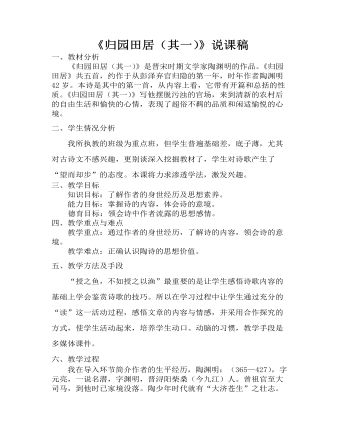
《归园田居(其一)》说课稿 2021-2022学年统编版高中语文必修上册
运用比较法,让学生讨论比较字词改换后与原诗在表达效果上有何异同,然后教师和同学们共同总结出原诗中的画线字词主要运用了比喻和拟人等修辞手法,显得既生动又含蓄,富有意境美,而改后的字词显得直白而又重复。通过文本研读部分的学习,学生对诗歌内容有了较深入的理解,为了使学生拓宽知识面,加强思想价值观的教育引导,在拓展练习部分我设置了一个探究性的问题,让学生谈谈如何看待陶渊明归隐的问题,我采用合作探究法,让学生分组互动讨论、自由发言。教师针对学生的发言,及时地加以点拨:陶渊明不与统治者合作,令人敬佩;歌唱田园风光,令人赞叹;归隐田园有独善其身,消极避世因素,这一点自然不应当苛求古人。

《百合花》《哦,香雪》说课稿 2022-2023学年统编版高中语文必修上册
1、导入:青春之美,弥足珍贵,青春的价值又各不相同,如果革命之志是毛泽东青春的美好,那蓬勃的创造力就是郭沫若的青春之歌,如果奉献与牺牲是闻一多青春的价值,那么自由就是雪莱青春的底色,我们前两节课遨游在诗歌的天空,那么我们这节课我们要来到小说的园地,看看青春在这片小说的沃土里展现怎样的颜色。目的:创设诗意,进入情境,延继单元主题,引出学习内容2、学习任务一:预习检查,概括情节目的:检查预习成果,落实整体感知把握主旨的课前学习任务。3、学习任务二:情境探究:品人物悟青春之美假设我校文学社正在举办“文学中最美的青春人物”评选活动,让同学在《百合花》与《哦,香雪》中推选出最能体现青春美好的人物,还需要附上简短的推荐理由以便评委组评议。谁最美?大家为此争论不休,如果你也参与推荐,那你觉得谁才是最美的青春人物?你会为他写上怎样的推荐理由?(思考提示:依据表格内容思考并完成表格,小组内交流3分钟,推选代表回答)
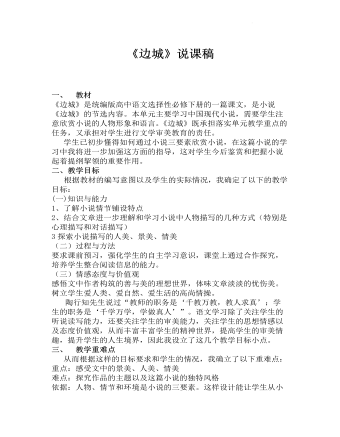
《边城》说课稿2021-2022学年统编版高中语文选择性必修下册
(重点突破一)1、分析环境描写 探讨边城的景美?(重点突破二)2、分析人物形象 探讨边城的人性美和人情美?至此,以三要素为切入口,文章的重点已分析完毕,下一个步骤就是突破难点。第二课时首先回顾上节课所讲的内容 (5分钟)(四)(难点突破)探究主题我设计了这样两个问题:1、小说表达了什么样的主题?(5分钟)2、有人说:《边城》从头到尾都隐藏着一种淡淡的愁绪,说说你的认识?从这篇小说中你可以看出沈从文先生的哪些显著的写作特点?(15分钟)这是两个定向设问的探究题,目的性很明确,就是为了突破难点,探究文章主旨。为了帮助学生理解文章的主旨,我用多媒体向学生 介绍《边城》的写作背景,给出“边城”的解题。对于第一个题,学生的答案可能会有很多种,比如“美”“爱”“纯”“和谐”“自然”等等,只要能基本概括,理由充足即可。
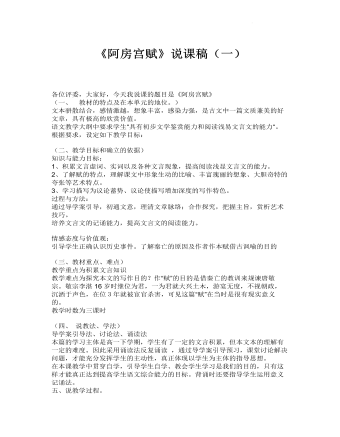
《阿房宫赋》说课稿(一) 2021-2022学年统编版高中语文必修下册
各位评委,大家好,今天我说课的题目是《阿房宫赋》 (一、 教材的特点及在本单元的地位。)文本骈散结合,感情激越,想象丰富,感染力强,是古文中一篇文质兼美的好文章,具有极高的欣赏价值。语文教学大纲中要求学生“具有初步文学鉴赏能力和阅读浅易文言文的能力“。根据要求,设定如下教学目标:(二、教学目标和确立的依据) 知识与能力目标:1、积累文言虚词、实词以及各种文言现象,提高阅读浅显文言文的能力。2、了解赋的特点,理解课文中形象生动的比喻、丰富瑰丽的想象、大胆奇特的夸张等艺术特点。3、学习描写为议论蓄势、议论使描写增加深度的写作特色。过程与方法:通过导学案引导,初通文意,理清文章脉络;合作探究,把握主旨,赏析艺术技巧。培养文言文的记诵能力,提高文言文的阅读能力。情感态度与价值观:引导学生正确认识历史事件。了解秦亡的原因及作者作本赋借古讽喻的目的
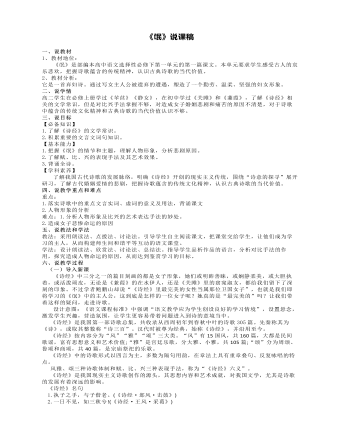
《氓》说课稿-2020-2021学年统编版高中语文选择性必修下册
“将子无怒”急于成婚,至于发怒,表现出急躁的性格特征;“二三其德”,又表现出他品德的败坏;“言既遂矣,至于暴矣”婚后的暴躁,婚前的热烈,婚后的离弃,两相对照,则揭示了他的虚伪自私。总之,氓是个性情狂暴、违背诺言、始爱终弃、不负责任、自私的负心汉。设计意图:用流行语概念引导学生去解读不同作品中的人物,培养学生比较分析的能力。3、探究《氓》中造成女子婚姻悲剧和痛苦的原因有哪些?个人原因:①氓的三心二意,不负责任。文中说“女也不爽,士贰其行”,女子怨恨的正是自己甘心贫困,辛苦操劳,多年如一日,但是最终还是被丈夫遗弃。②女子在经济上政治上处于附属地位。她生活天地狭小,生活的幸福与否全寄托在丈夫身上。如果遇上个对感情对家庭不负责任的丈夫,那她的悲剧是不可避免的。③性格悲剧。在男权社会中,女子在婚前行为草率,她与氓的恋爱缺乏牢固的思想基础,对氓的人品认识不足,认人不清导致的悲剧。社会的原因:
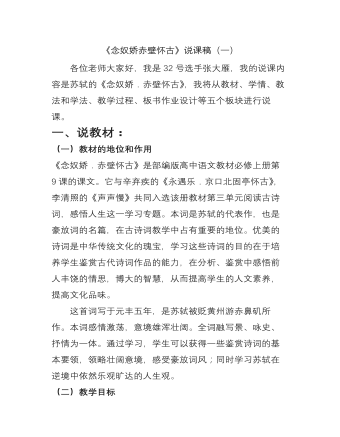
《念奴娇 赤壁怀古》说课稿(一) 统编版高中语文必修上册
一、说教材:(一)教材的地位和作用《念奴娇﹒赤壁怀古》是部编版高中语文教材必修上册第9课的课文。它与辛弃疾的《永遇乐﹒京口北固亭怀古》,李清照的《声声慢》共同入选该册教材第三单元阅读古诗词,感悟人生这一学习专题。本词是苏轼的代表作,也是豪放词的名篇,在古诗词教学中占有重要的地位。优美的诗词是中华传统文化的瑰宝,学习这些诗词的目的在于培养学生鉴赏古代诗词作品的能力,在分析、鉴赏中感悟前人丰饶的情思,博大的智慧,从而提高学生的人文素养,提高文化品味。这首词写于元丰五年,是苏轼被贬黄州游赤鼻矶所作。本词感情激荡,意境雄浑壮阔。全词融写景、咏史、抒情为一体。通过学习,学生可以获得一些鉴赏诗词的基本要领,领略壮阔意境,感受豪放词风;同时学习苏轼在逆境中依然乐观旷达的人生观。





















